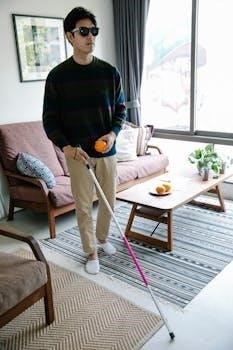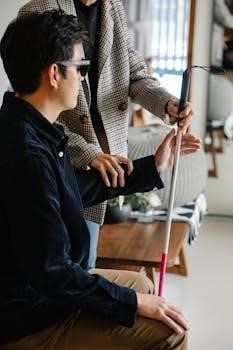Needle Guide Assistant⁚ A Comprehensive Overview
Needle guide assistants are versatile tools, enhancing precision in medical procedures and sewing tasks. They improve accuracy, reduce procedure time, and ensure patient safety. These systems incorporate reusable and disposable components, often integrating with advanced technologies like 3D guidance.
Needle guide assistants enhance precision in various fields, including medical procedures and sewing applications. These tools improve needle visualization and patient safety during ultrasound-guided interventions. They reduce procedure time and patient discomfort. In sewing, needle guides ensure accurate fabric alignment and consistent stitch placement. These assistants utilize different needle systems, points, and sizes to accommodate diverse material types and project requirements. They are designed for user-friendly operation and improved overall efficiency.
Types of Needle Guide Assistants
Needle guide assistants vary widely, designed for specific applications. Key types include those used in ultrasound procedures for accurate needle placement and those integrated into sewing machines for precise fabric manipulation and stitch control.
Needle Guides for Ultrasound Procedures
Needle guides for ultrasound procedures are tools designed to enhance precision during ultrasound-guided interventions. They improve needle visualization, patient safety, and reduce procedure time and discomfort. Some systems, like CIVCO’s, utilize a two-part system with a reusable tracking bracket and disposable guide. These guides maintain tactile feel while offering needle guidance. Prototypes include lockable, articulating guides attaching to ultrasound probes.
Needle Guides for Sewing Machines
Needle guides for sewing machines aid in precise fabric manipulation, ensuring consistent stitch placement. These guides often feature adjustable settings to accommodate various fabric thicknesses and seam allowances. Certain models incorporate magnetic attachments for easy positioning and removal. They are invaluable for achieving professional-looking results in quilting, garment construction, and other sewing projects, promoting accuracy and efficiency.
Key Features and Benefits
Needle guide assistants offer improved precision, enhanced safety in medical contexts, and reduced procedure times. These features provide significant advantages, ensuring accurate needle placement and minimizing patient discomfort during various applications.
Improved Precision and Accuracy
Needle guide assistants significantly enhance the precision and accuracy of needle placement in various applications. In medical procedures, these guides ensure that needles reach the intended target with minimal deviation, crucial for biopsies and injections. For sewing and quilting, they provide consistent stitch alignment. This enhanced accuracy reduces errors, improves outcomes, and minimizes the need for repeat procedures, contributing to overall efficiency and effectiveness.
Enhanced Patient Safety (Medical Applications)
Needle guide assistants play a crucial role in enhancing patient safety during medical procedures. By improving needle visualization and accuracy, these guides minimize the risk of unintended punctures or damage to surrounding tissues and vessels. The use of disposable components, such as snap-on guides, helps maintain sterility and reduce the potential for infection. Ultimately, needle guide assistants contribute to safer and more controlled interventions.
Reduced Procedure Time and Discomfort
Needle guide assistants contribute to the reduction of procedure time and patient discomfort. By offering enhanced precision and accuracy in needle placement, these guides minimize the need for multiple attempts, thus shortening the overall duration of the procedure. This, in turn, reduces patient anxiety and discomfort. Features like easy attachment to ultrasound probes further streamline the process, making it more efficient for both the practitioner and the patient.

Needle Systems and Compatibility
Needle systems define machine compatibility, while various points cater to different materials. Sizes determine hole and thread dimensions. Understanding these factors ensures optimal performance and prevents damage to the machine or materials being worked on.
Understanding Needle Systems for Sewing Machines
Sewing machine needle systems are crucial for compatibility. Each system, identified by numbers/characters, determines if a needle fits a specific machine. Referencing your machine’s manual is key to selecting the correct system. Groz-Beckert systems are widely recognized, with various manufacturers offering compatible options. Using the right system prevents damage and ensures proper stitch formation, impacting overall sewing quality and efficiency.
Needle Selection Based on Material and Thread Type
Selecting the right needle involves considering both material and thread. Finer fabrics require smaller needles, while heavier materials need larger ones. The needle size should correspond to the thread thickness; thicker threads necessitate larger needle eyes. Using incompatible needles leads to skipped stitches, fabric damage, and thread breakage. Color bands on needles often indicate the type and size, aiding in proper selection for successful sewing projects.

Ultrasound Needle Guide Systems
Ultrasound needle guide systems enhance precision during interventions. They improve needle visualization, patient safety, and reduce procedure time. These systems utilize reusable tracking brackets and disposable guides for optimal performance.
Reusable and Disposable Components
Ultrasound needle guide systems often incorporate both reusable and disposable components. Reusable parts, such as tracking brackets, are designed for repeated use after proper cleaning and sterilization. Disposable snap-on guides ensure sterility and prevent cross-contamination between patients. This combination offers a balance of cost-effectiveness and safety, enhancing the overall efficiency of ultrasound-guided procedures. The brackets can be cleaned and disinfected, while the snap-on needle guide is disposable, improving patient safety.
Integration with Ultrasound Probes
Needle guide assistants designed for ultrasound procedures are specifically engineered for seamless integration with ultrasound probes. These guides attach securely to the probe, providing a stable and accurate pathway for needle insertion. This integration enhances needle visualization, allowing clinicians to precisely target areas of interest. Features like lockable, articulating designs and custom brackets ensure compatibility and ease of use, improving the accuracy and efficiency of ultrasound-guided interventions. Proper integration maintains tactile feel during the procedure.

Needle Size and Measurement
Needle size is crucial, with metric (e.g., 35 to 250) and US systems defining diameter. Selecting the correct size ensures compatibility with thread and material. Understanding these systems is essential for successful sewing or medical procedures.
Metric and US Sizing Systems
Needle sizes are indicated using two primary systems⁚ metric and US. The metric system measures the needle’s diameter in hundredths of a millimeter, ranging from 35 to 250. The US system uses a different numbering scheme, with sizes like 7 to 19. Understanding both systems is crucial for selecting the appropriate needle.
For example, needles range in size from very fine 55/7 to a heavy duty needle 120/19. Most needles use the two-number measuring system. The higher number relates to the metric system and defines the needle shaft diameter in hundredths of a millimeter. The lower number relates to the system in the U.S.
Relationship Between Needle Size and Thread Size
The selection of needle size is intrinsically linked to the thread’s thickness. Thicker threads necessitate larger needles to create adequately sized holes, preventing thread breakage and ensuring smooth stitching. Conversely, finer threads require smaller needles to avoid excessively large holes in the fabric. For example, if you’re using size 69 thread, you should use size 18 needle. If you’re using size 138 thread, you should use size 23 needle.
Advanced Technologies in Needle Guidance
Advanced needle guidance incorporates 3D systems for enhanced accuracy and robotic assistance for precise insertion. These technologies improve visualization and reduce errors in medical procedures, ensuring optimal outcomes and patient safety through innovative solutions.
3D Guidance Systems
3D guidance systems provide real-time visualization of needle positions, enhancing accuracy in complex procedures. These systems often feature high measurement accuracy and low latency, essential for image-guided surgeries. Incorporating virtual protractors, they assist with three-dimensional needle punctures at any angle. The training modules offer realistic experiences, improving skills and confidence. Such systems are valuable tools for precise and safe interventions.
Robotic-Assisted Needle Insertion
Robotic-assisted needle insertion utilizes advanced imaging techniques, such as computed tomography (CT), to guide procedures with greater precision. These systems enhance accuracy and reduce the risk of complications. Feasibility studies highlight their potential in various medical applications. The integration of robotic assistance ensures consistent and controlled needle placement. This technology represents a significant advancement in minimally invasive procedures, improving patient outcomes and procedural efficiency.

Applications in Various Fields
Needle guide assistants find applications in diverse fields. In medicine, they aid biopsies and injections. For sewing and quilting, they enhance precision and efficiency. These tools improve outcomes across medical and crafting domains.
Medical Procedures (Biopsies, Injections)
In medical procedures, needle guide assistants significantly enhance the accuracy of biopsies and injections. These tools improve needle visualization under ultrasound guidance, ensuring precise targeting of tissues and reducing the risk of complications. Enhanced precision translates to safer and more effective diagnostic and therapeutic interventions. The use of needle guides also minimizes patient discomfort and procedure time, improving overall patient experience.
Sewing and Quilting
In sewing and quilting, needle guide assistants offer enhanced precision and control, particularly beneficial for intricate designs and consistent stitch placement. These tools ensure accurate fabric alignment, preventing slippage and maintaining uniform seam widths. They are especially useful for beginners and experienced sewers alike, improving project outcomes and reducing errors. Furthermore, needle guides contribute to faster sewing speeds and reduced fatigue by providing a stable and reliable guide.
Choosing the Right Needle Guide Assistant
Selecting a needle guide assistant requires careful consideration of purpose, compatibility, and desired features. Evaluating different manufacturers and brands is crucial to finding a tool that meets specific needs and ensures optimal performance.
Factors to Consider (Purpose, Compatibility, Features)
When choosing a needle guide assistant, define its primary purpose⁚ medical procedures like biopsies or sewing/quilting. Ensure compatibility with existing equipment, such as ultrasound probes or sewing machines, as mentioned in online guides. Key features include precision, adjustability, and ease of use. Reusable or disposable options should also factor into your decision, ensuring cost-effectiveness and sterilization capabilities.
Manufacturers and Brands
Several manufacturers offer needle guide assistants. CIVCO provides guidance systems for medical ultrasound, with reusable brackets and disposable guides. For sewing applications, SCHMETZ is renowned for high-quality sewing machine needles, offering a variety for different projects. Klassé also produces needles suitable for overlockers and sergers. Consider brands like Groz-Beckert for compatible needle systems to find the best option.
Maintenance and Care
Needle guide assistants require proper care. Medical applications necessitate cleaning and sterilization to prevent infection. Proper storage and handling are vital for all types of needle guide assistants to maintain functionality and longevity.
Cleaning and Sterilization (Medical Applications)
For medical needle guide assistants, rigorous cleaning and sterilization protocols are paramount. Reusable components must undergo thorough disinfection to eliminate pathogens. Autoclaving or chemical sterilization methods may be employed, following manufacturer guidelines. Disposable elements minimize infection risk. Proper procedures ensure patient safety by preventing cross-contamination. Regular maintenance and adherence to sterilization standards extend the lifespan of reusable needle guide assistant components while upholding the highest hygiene levels.
Proper Storage and Handling
Proper storage and handling of needle guide assistants, especially in medical settings, is crucial to maintain their integrity and functionality. Clean, dry environments are essential to prevent contamination. Protect delicate components from physical damage by using designated cases or trays. Follow manufacturer’s recommendations for temperature and humidity control. Train staff in correct handling techniques to avoid accidental drops or misuse. Regular inspection for wear and tear is also vital to ensure optimal performance.

No Responses